Kasur
Kasur (Urdu: قصُور pronounced [qa:soo:r] (![]() listen); also romanized as Qasūr; from Arabic Qasr meaning "palace"[2]) is a city to south of Lahore, in the Pakistani province of Punjab. The city serves as the headquarters of Kasur District. Kasur is the 24th largest city of Pakistan by population.[3] It is also known for being the burial place of the 17th-century Sufi-poet Bulleh Shah. It is farther west of the border with neighbouring India, and bordered to Lahore, Sheikhupura, and the Okara District of Punjab Province.[4][5][6]
listen); also romanized as Qasūr; from Arabic Qasr meaning "palace"[2]) is a city to south of Lahore, in the Pakistani province of Punjab. The city serves as the headquarters of Kasur District. Kasur is the 24th largest city of Pakistan by population.[3] It is also known for being the burial place of the 17th-century Sufi-poet Bulleh Shah. It is farther west of the border with neighbouring India, and bordered to Lahore, Sheikhupura, and the Okara District of Punjab Province.[4][5][6]
Kasur
قصُور Qasūr | |
|---|---|
City | |
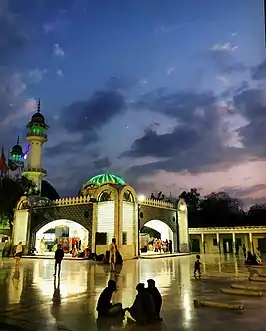   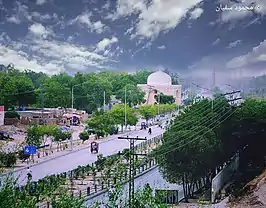 Clockwise from the top: Tomb of Bulleh Shah, Tomb of Shah Kamal Chisti, Skyline around Kasur Museum, Veranda of the Tomb of Bulleh Shah | |
 Municipal Committee Emblem | |
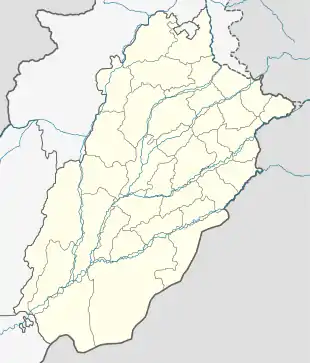 Kasur 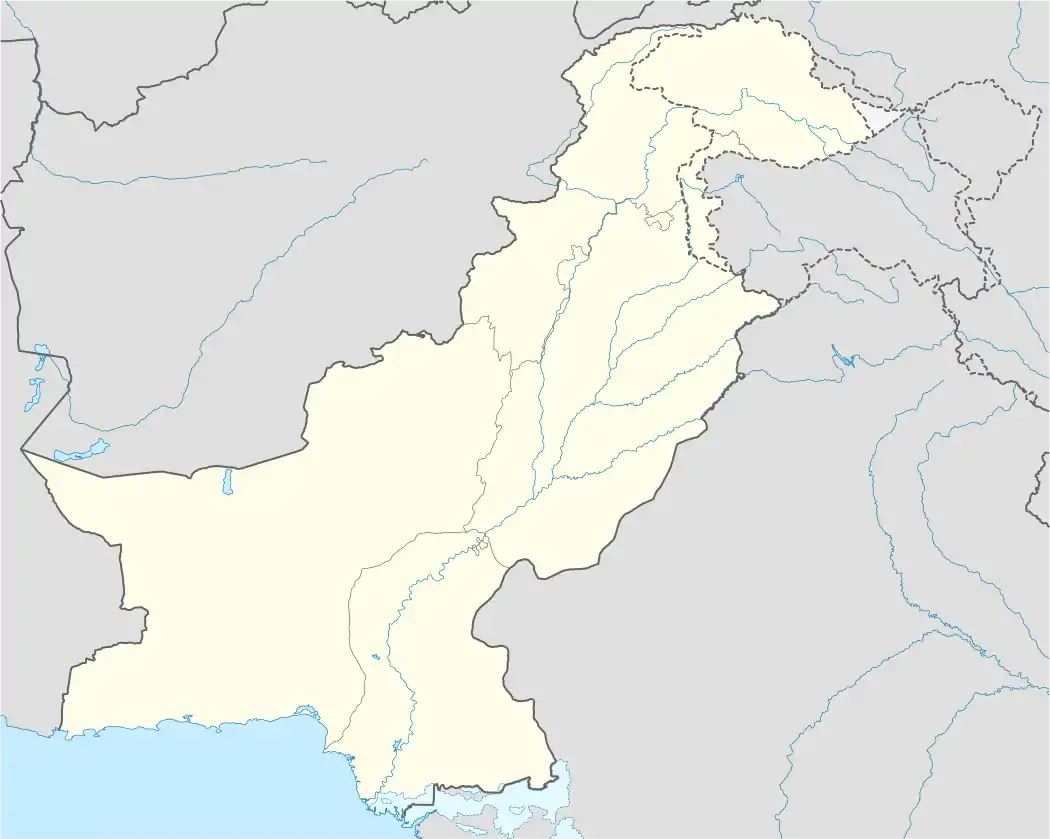 Kasur | |
| Coordinates: 31°7′0″N 74°27′0″E | |
| Country | |
| Province | |
| Division | Lahore |
| District | Kasur |
| Founded by | Kheshgi tribe of Pashtuns |
| Government | |
| • Nazim | Manzar Javed Ali |
| Area | |
| • City | 3,995 km2 (1,542 sq mi) |
| Elevation | 218 m (715 ft) |
| Population (2020)[1] | |
| • City | 382,000 |
| • Rank | 24th, Pakistan |
| Demonym(s) | Kasuri |
| Time zone | UTC+5 (PST) |
| Calling code | 049 |
| Website | punjab |
Etymology
Kasur derives its name from the Arabic word qasur (قصور),[7][8] meaning “palaces,” or “forts.” Hindu traditions claim that Kasur was founded by, and named for, Prince Kusha of the Ramayana,[9] son of the Hindu deities Rama and Sita. According to it, the city was named along with its neighbouring city, Lahore. Historical records reject an ancient mythological founding of the city and dates it back to 1525, where it was found as a fortified settlement. [10][11][12][13]
History

Early
Kasur region was an agricultural region with forests during the Indus Valley Civilization. The Kasur region was ruled variously by the Maurya Empire, Indo-Greek kingdom, Kushan Empire, Gupta Empire, White Huns, Kushano-Hephthalites and Kabul Shahi kingdoms.
Founding
Kasur was established as a city by the Kheshgi tribe of Pashtuns who had migrated to the region in 1525 from Afghanistan,[14] during the reign of Babur, and built several small forts in the area.[15][16]
Mughal
Under Mughal rule, the city flourished and was notable for commerce and trade. It became the home of the legendary Sufi saint and celebrated poet, Bulleh Shah, who is buried in a large shrine in the city.
Sikh
After the decline of the Mughal Empire, the Kasur region fell into a power vacuum. Kasur was captured by Ahmad Shah Durrani, though Sikhs sacked the city in 1747 under Jassa Singh Ahluwalia,[17] and again in 1763 after Durrani shifted to Afghanistan.[18] The Sikh Empire under Ranjit Singh then captured the city in 1807.[19] During the First Anglo-Sikh War, the city was occupied by Company forces on February 10, 1846.[20]
British
During the British Raj, the irrigation canals were built that irrigated large areas of the Kasur District. Communal disturbances between Sikhs, Hindus, and Muslims erupted in 1908 over the issue of meat sales.[21] Riots erupted following the Jallianwala Bagh massacre on 12 April 1919, leading to the destruction of civic infrastructure, including the city's railway station.[22] Martial law was imposed on 16 April 1919 in response to the riots.[23]
Modern
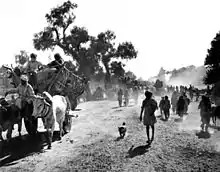
After the independence of Pakistan in 1947, the minority Hindus and Sikhs were to migrate to India while the Muslim refugees, migrated from India and settled in Kasur. Kasur emerged as a major center of leather tanning after independence, and is home to 1/3rd of Pakistan's tanning industry.[24]
In January 2018, two protestors were killed in rioting over the rape and murder of a seven-year-old girl. There had been 12 similar murders in the past two years, five of which have been linked to one suspect, leading to widespread anger at police failures.[25][26]
In November 2020, Russia signed a 1,122-km high pressure RLNG pipeline from Port Qasim, Karachi to Kasur.[27]
Geography
Kasur is bordered to the north by Lahore, by India to the south and east, it also has borders with Okara and Nankana Sahab district, the city is adjacent to the border of Ganda Singh Wala, a border with its own flag-lowering ceremony.
Climate
Kasur has a semi-arid climate (Köppen climate classification BSh). Kasur has extremes of climate; the summer season begins from April and continues till September. June is the hottest month. The mean maximum and minimum temperature for this month are about 45 °C (113.0 °F) and 27 °C (80.6 °F) respectively. The winter seasons lasts from November to February. January is the coldest month. The mean maximum and minimum temperatures for the coldest month are 22 °C (71.6 °F) and 0 °C (32.0 °F) respectively. Rainfall towards the end of June monsoon conditions appear and during the following two and a half months the rainy season alternates with sultry weather. The winter rain falls during January, February and March ranging from 23 millimetres (0.91 in) to 31 millimetres (1.2 in). Water logging and salinity has effected a large area of the district making the underground water brackish.[28]
| Climate data for Kasur, Pakistan | |||||||||||||
|---|---|---|---|---|---|---|---|---|---|---|---|---|---|
| Month | Jan | Feb | Mar | Apr | May | Jun | Jul | Aug | Sep | Oct | Nov | Dec | Year |
| Record high °C (°F) | 27.0 (80.6) |
31.0 (87.8) |
37.0 (98.6) |
43.0 (109.4) |
47.0 (116.6) |
48.0 (118.4) |
42.0 (107.6) |
39.0 (102.2) |
39.0 (102.2) |
37.0 (98.6) |
38.0 (100.4) |
29.0 (84.2) |
48.0 (118.4) |
| Average high °C (°F) | 21.0 (69.8) |
22.0 (71.6) |
28.0 (82.4) |
33.0 (91.4) |
37.0 (98.6) |
38.0 (100.4) |
36.0 (96.8) |
34.0 (93.2) |
33.0 (91.4) |
31.0 (87.8) |
27.0 (80.6) |
22.0 (71.6) |
30.2 (86.3) |
| Daily mean °C (°F) | 14 (57) |
19 (66) |
19 (66) |
24 (75) |
27 (81) |
24 (75) |
21 (70) |
25 (77) |
30 (86) |
27 (81) |
20 (68) |
18 (64) |
22 (72) |
| Average low °C (°F) | 6.0 (42.8) |
10.0 (50.0) |
14.0 (57.2) |
9.0 (48.2) |
23.0 (73.4) |
26.0 (78.8) |
27.0 (80.6) |
26.0 (78.8) |
23.0 (73.4) |
18.0 (64.4) |
10.0 (50.0) |
7.0 (44.6) |
16.6 (61.9) |
| Record low °C (°F) | −2.0 (28.4) |
2.0 (35.6) |
6.0 (42.8) |
9.0 (48.2) |
13.0 (55.4) |
13.0 (55.4) |
13.0 (55.4) |
13.0 (55.4) |
10.0 (50.0) |
6.0 (42.8) |
3.0 (37.4) |
−1.0 (30.2) |
−2.0 (28.4) |
| Average precipitation mm (inches) | 0 (0) |
3 (0.1) |
0 (0) |
3 (0.1) |
0 (0) |
5 (0.2) |
5 (0.2) |
6 (0.2) |
1 (0.0) |
1 (0.0) |
6 (0.2) |
0 (0) |
30 (1) |
| Mean monthly sunshine hours | 279 | 252 | 341 | 360 | 403 | 390 | 341 | 310 | 330 | 341 | 300 | 310 | 3,957 |
| Source: MyWeather2 [29] | |||||||||||||
Religion
The population in Kasur is predominantly Muslim with some small Christian and Hindu minorities. In a census conducted by the Office of the Census Commissioner in 1951, the result was that 96% of the population of Kasur was Muslim with 0.004 being Hindu minorities and 0.034 being Christian minorities.[30]
Notable people

- Bulleh Shah, a Sufi saint and spiritual poet
- Hafiz Ghulam Murtaza, teacher of Bulleh Shah and Waris Shah
- Noor Jehan, singer and actress
- Baba Lal Dayal, a saint
- Sardar Talib Hassan Nakai, Member of National Assembly Of Pakistan.Senior politician of Dist Kasur.5th time MNA.EX Federal Minister.
- Malik Meraj Khalid former Speaker of National Assembly of Pakistan, former Prime Minister of Pakistan
- Ahmad Raza Khan Kasuri, former member of National Assembly of Pakistan
- Irshad Ahmed Haqqani, journalist, writer
- Phool Muhammad Khan, politician
- Basit Jehangir Sheikh, Politician, Youngest Founder Member Pakistan Peoples Party(P.P.P)
- Rana Muhammad Iqbal Khan former speaker Punjab assembly
- Aseff Ahmad Ali, former Foreign Minister
- Khurshid Mahmud Kasuri, former Foreign Minister
- Bade Ghulam Ali Khan, a Hindustani classical vocalist
- Barkat Ali Khan, a Hindustani classical vocalist
- Pran Kumar Sharma, an Indian cartoonist
- Najam Sethi, journalist, writer, Pakistan Cricket Board chairman
- Abdul Hamid, former Auditor General of Pakistan
- Tahir Aslam Gora, a Canadian editor and publisher
- Sardar Arif Nakai, former Chief Minister of Punjab
- Sardar Tufail Ahmad Khan, former MPA and MNA, Parliamentary
- Sardar Muhammad Asif Nakai, Member of the Punjab Provincial Assembly
- Jagga Jatt, 20th century rebel of Punjab
- Maharani Datar Kaur, Wife of Maharajah Ranjit Singh
- Fateh Muhammad Sial, first Ahmadi missionary sent from India
References
- "Kasur, Pakistan Metro Area Population 1950-2020". www.macrotrends.net.
- "Kasur | Punjab Portal". punjab.gov.pk. Retrieved 2020-08-24.
- "Pakistan: Provinces and Major Cities - Population Statistics, Maps, Charts, Weather and Web Information". www.citypopulation.de.
- Chopra, Gulshan Lall (1940). Chiefs and Families of Note in the Punjab. Government Printing.
- Garg, Sanjay (30 August 2018). Studies in Indo-Muslim History by S.H. Hodivala Volume II: A Critical Commentary on Elliot and Dowson's History of India as Told by Its Own Historians (Vols. V-VIII) & Yule and Burnell's Hobson-Jobson. Routledge. ISBN 978-0-429-75777-8.
... Kheshgi , which was the name of the Afghān tribe to which Naz̤r Bahādur Khān belonged (M.U. III. 777, l. 14). The Kheshgis were famous for their piety and integrity and were settled round about Lāhor and Kāsūr
- Low, D. A. (18 June 1991). Political Inheritance of Pakistan. Springer. ISBN 978-1-349-11556-3.
The third family, the Kheshgi Afghans of Kasur, had held distinguished posts under the Mughals since ...
- Singh, Maya; Clark, Henry Martyn (1895). The Panjábí Dictionary. Munshi Gulab Singh & sons.
Kasur.
- Chopra, Gulshan Lall (1940). Chiefs and Families of Note in the Punjab. Government Printing.
- Nadiem, Ihsan N (2005). Punjab: land, history, people. Al-Faisal Nashran. p. 111. ISBN 9789695034347. Retrieved 2009-05-29.
- Nadiem, Ihsan H. (2005). Punjab: land, history, people. al-Faisal Nashran. ISBN 9789695032831.
- Chopra, Gulshan Lall (1940). Chiefs and Families of Note in the Punjab. Government Printing.
- Garg, Sanjay (30 August 2018). Studies in Indo-Muslim History by S.H. Hodivala Volume II: A Critical Commentary on Elliot and Dowson's History of India as Told by Its Own Historians (Vols. V-VIII) & Yule and Burnell's Hobson-Jobson. Routledge. ISBN 978-0-429-75777-8.
... Kheshgi , which was the name of the Afghān tribe to which Naz̤r Bahādur Khān belonged (M.U. III. 777, l. 14). The Kheshgis were famous for their piety and integrity and were settled round about Lāhor and Kāsūr
- Low, D. A. (18 June 1991). Political Inheritance of Pakistan. Springer. ISBN 978-1-349-11556-3.
The third family, the Kheshgi Afghans of Kasur, had held distinguished posts under the Mughals since ...
- Chopra, Gulshan Lall (1940). Chiefs and Families of Note in the Punjab. Government Printing.
- Sikand, Yoginder (19 July 2011). Beyond The Border. ISBN 9789352141326.
- Nadiem, Ihsan H. (2005). Punjab: land, history, people. al-Faisal Nashran. ISBN 9789695032831.
- Singha, Dr H. S. (2005). Sikh Studies. Hemkunt Press. ISBN 9788170102588.
- Lansford, Tom (2017-02-16). Afghanistan at War: From the 18th-Century Durrani Dynasty to the 21st Century. ABC-CLIO. ISBN 9781598847604.
- Lansford, Tom (2017-02-16). Afghanistan at War: From the 18th-Century Durrani Dynasty to the 21st Century. ABC-CLIO. ISBN 9781598847604.
- Singh, Amarpal (2010-08-15). The First Anglo-Sikh War. Amberley Publishing Limited. ISBN 978-1-4456-2038-1.
- Khawaja, Sarfraz (1985). Sikhs of the Punjab, 1900-1925: a study of confrontation & political mobilization. Modern Book Depot.
- Chopra, Gulshan Lall (1940). Chiefs and Families of Note in the Punjab. Government Printing.
- Punjab Through the Ages. Sarup & Sons. 2007. p. 133. ISBN 9788176257381.
kasur.
- Heiden, Pete (2011-09-01). Pakistan. ABDO Publishing Company. ISBN 9781617878275.
- "Zainab murder: Riots in Pakistan's Kasur after child rape and killing". BBC News. 10 January 2018.
- "Pakistani anchor goes on air with daughter to protest minor's brutal rape and murder". The Times of India. 11 January 2018.
- Mustafa, Khalid (19 November 2020). "Karachi-Kasur gas pipeline project: Pakistan, Russia sign amended gas pipeline accord". The News International.
- https://punjab.gov.pk/kasur_climate
- "Kasur Climate History". Weather2. Retrieved 2019-12-03.
- CENSUS OF RAKISTAN, 1951 (PDF).
External links
- Hasan Saeed Kasur Safe City Project
- Minister inspects progress on Kasur Safe City Project July 27, 2019
- Kasur Safe City Project: PSCA connects CCTV cameras with IC3 Lahore June 26, 2019 CM inaugurates three mega projects in Kasur July 26, 2019
- Failsal Saeed Punjab govt all set to launch safe city project in yet another district April 16, 2019
